Q1. In a girdled plant, which part
dies first?
Solution
In a girdled plant, the roots die
first. This is because the xylem of the plant transports water and minerals
from the soil to the upper part of the plant. However, because of the absence
of phloem, there is no transport of food to the lower part of the plant,
resulting in its death.
Q2. The rupture and fractionation do not usually occur in the water column in vessel/tracheids during the ascent of sap because of
Solution
There are a large number of treachery elements running together, the blockage of one or a few of them does not cause any breakage in the continuity of the water column. The column of water does not fall under the impact of gravity because forces of transpiration provide energy. Water molecules remain attached to one another by strong mutual forces of attraction called cohesion and adhesion forces.
Q3. Cohesion-tension theory is related to
Solution
Cohesion-tension
theory is called Dixon’s theory of ascent of sap because it was put forward
by Dixon and Jolly in 1894. This theory is based on the features of cohesion,
adhesion and tension.
Q4. Who among the following
experimentally demonstrated that tension develops in the xylem during rapid
transpiration?
Solution
Scholander demonstrated that tension
develops in the xylem during rapid transpiration.
Q5. The pressure flow hypothesis was
proposed by
Solution
The pressure flow hypothesis or
the mass flow theory was first proposed by Munch in 1930 and was elaborated
by Crafts in 1938.
Q6. The hydathode helps in
Solution
Hydathodes are usually found on the margins and tips of leaves. So,
the excretion of water is due to the development of a positive pressure in
the xylem present in the vein ending. The pressure forces the liquid out
through the hydathode which is called guttation.
Q7. Who gave the idea that energy released during respiration is responsible for absorption of water?
Solution
Thimann observed that absorption rate and respiration rate are closely related which gave the idea that energy released during respiration is responsible for absorption of water.
Q8. Which does not pertain to facilitated
transport?
Solution
Facilitated
transport is the transport of substances along the concentration gradient
through fixed membrane transport proteins without involving energy
expenditure, but it is not uphill transport. It is otherwise called active
transport which employs ATP energy for transport across the membrane.
Q9. The process by which water is absorbed
by solids such as colloids causing them to increase in volume is called
Solution
Imbibition is the absorption or adsorption of water by
certain colloids, with resultant swelling of tissues as in seeds.
Q10. When a cell is plasmolysed, it becomes
Solution
In plasmolysis, the pressure potential or the turgor pressure (TP) is zero, and the osmotic concentration of the cell interior is equal to that of the external solution, making the cell flaccid.
Q11. A cell when kept in a sugar solution
gets dehydrated. Then the solution is
Solution
Hypertonic solutions have a higher solute concentration which causes
the water inside a cell to get out of the cell by osmosis.
Q12. The pathway of the movement of
water through the cell wall only is called
Solution
The passing of water from
root hair to xylem through the walls of intervening cells without crossing
any membrane or cytoplasm is called the apoplast pathway.
Q13. All the
minerals cannot be passively absorbed by the roots. Justify.
Solution
Minerals
are present in the soil as charged particles which cannot move across the
cell membranes.
The
concentration of minerals in the soil is usually lower than the concentration
of minerals in the root.
Hence,
all the minerals cannot be passively absorbed by the roots.
Q14. State the
rate of the upward flow of water in the xylem of plants.
Solution
The rate
of the upward flow of water in the xylem of plants is 15 metres per hour.
Q15. The rate of diffusion will be less
in
Solution
The rate of diffusion will be less
in a concentrated solution.
Q16. A cell when dipped in 0.5 M sucrose solution has no effect, but when the same cell is dipped in 0.5 M NaCl solution, the cell will
Solution
A hypertonic solution such as sucrose causes exosmosis or withdrawal of water from the cytoplasm. The pressure on the wall is simultaneously reduced and the elastic wall contracts causing a reduction in cell size which is called plasmolysis.
Q17. According to Munch’s hypothesis,
when the plant is defoliated,
Solution
According to Munch’s hypothesis,
the positive concentration gradient disappears when the plant is defoliated.
Q18. Lenticels are found in
Solution
Lenticels are found in fruits and
woody cells and help in transpiration and gaseous exchange.
Q19. The instrument used for measuring the rate of transpiration is
Solution
A potometer is a device used to measure the rate of transpiration or the rate of loss of water from the leaves of a plant.
Q20. Which of the following chemical serves as an antitranspirant in plants?
Solution
Substances which reduce the rate of transpiration are called antitranspirants. The most used transpirant is phenyl mercuric acetate (PMA). PMA increases the leaf resistance to water vapour diffusion without affecting carbon dioxide uptake.
Q21. Which of the following is a
hydrophilic substance?
Solution
Silica is a hydrophilic substance,
while the rest are hydrophobic in nature.
Q22. Cohesion and adhesion theory is otherwise called
Solution
The upward movement of water is mainly due to the creation of a negative force or tension attributed to the continuous evaporation of water at the surfaces of leaves in the process of transpiration. As molecule after molecule of water evaporates through the stomata, it creates a pulling action on the next molecule of water in the transpiration stream. This pulling force, otherwise called transpiration pull, is strong enough to overcome the force of gravity which is responsible for the tendency of water to move downward.
Q23. Show
diagrammatically symplastic and apoplastic pathways for ion and water
movement in the root hair cells.
Solution
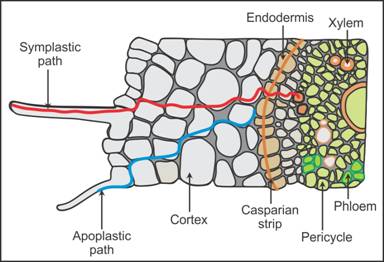
Q24. In the senescence stage of a
plant, the rate of transpiration is
Solution
The rate of transpiration reduces
in the senescence stage.
Q25. The osmotic pressure of mesophyll
cells of the leaf increases due to
Solution
The osmotic pressure of mesophyll
cells of the leaf increases because of the continuous synthesis of
carbohydrates by photosynthesis.
Q26. Which theory did Crafts elaborate
on?
Solution
Munch proposed the mass flow
theory (Munch’s theory) in 1930, which Crafts elaborated on in 1938.
Q27. Guttation is the result of
Solution
Guttation usually occurs during periods of active growth when conditions favour more water absorption and less transpiration. Due to the high root pressure, water is forced out into the intercellular space and flows out of the hydathodes.
Q28. Potometer works on the principle of
Solution
A potometer is a device used to measure the rate of transpiration, or the rate of loss of water, from the leaves of a plant.
A potometer experiment can be performed for measuring the amount of water lost per unit time when different environmental aspects are varied.
Plants when exposed to variations in the environmental conditions will transpire at different rates from those at normal room conditions.
Q29. Water potential is expressed in
Solution
The water potential is expressed
in Pascal.
Q30. Which of the following statements are true/false?
a. The positive hydrostatic pressure is called turgor
pressure.
b. Wall pressure is exerted to prevent the increase of protoplasm size.
c. Diffusion is more rapid in liquids than in gases.
d. Diffusion of water through a semi-permeable
membrane is called imbibition.
e. Osmosis is the movement of substances which occurs along a diffusion gradient.
Solution
a. Turgor pressure is the water pressure of the cell vacuole pushing against the cell wall.
b. As turgor pressure exerts its impact on to the cell wall, the cell wall, being plastic, exerts a counter pressure which is called wall pressure which prevents an increase of protoplasm size.
c. Diffusion depends on the number of particles per unit volume, density of medium, temperature and pressure. Therefore, gases diffuse more rapidly than liquids.
d. The absorption or adsorption of water by certain colloids, as in seeds, with resultant swelling of the tissues is called imbibition.
e. Osmosis is a type of diffusion of water which occurs through a semi-permeable membrane.
Q31. Differentiate between hypotonic and isotonic
solutions.
Solution
Hypotonic Solution
Isotonic Solution
The
solution does not balance the osmotic pressure of the cell, because its
water potential is greater than the cytoplasm of the cell.
The
solution balances the osmotic pressure of the cell.
There
is a flow of water inside the cell, and the cell swells up.
There is
no net flow of water inside or outside, and the cell remains flaccid.
Q32. Plasmolysis is the result of
Solution
Plasmolysis is the result of
exosmosis or the withdrawal of water from the cytoplasm. The pressure on the
wall is simultaneously reduced, and the elastic wall contracts causing a
reduction in cell size.
Q33. Phloem sap is mainly made of
Solution
In the phloem sap,
water and sucrose are carried throughout the parts of the plant by the
vascular system.
Q34. Absorption
of diffusible ions by cells against the concentration gradient is called
Solution
The
absorption of cells against the concentration gradient is said to be active
absorption.
Q35. During the process of respiration,
the movement of CO2 and O2 out and inside the cell is
achieved by
Solution
The inside and outside movement of
CO2 and O2 during respiration and photosynthesis is
achieved by independent diffusion.
Q36. Compare the statements A and B.
Statement A: To counteract the increase in turgor pressure in plant cells, the
cell wall produces an equal and opposite pressure, i.e. wall pressure.
Statement B: When plant cells undergo endosmosis, they swell but do not burst.
Solution
When water enters the living cell, a pressure is developed within the
cell due to turgidity.
The hydrostatic pressure developed inside the cell on the cell wall
due to endosmosis is called turgor pressure.
When the wall pressure equals the turgor pressure, the entry of water
into the cell stops. Therefore, the cell wall does not burst and the cells
swell.
Q37. Define plasmolysis.
Solution
Plasmolysis is the process in which the water
moves out of the plant cell, and the cell membrane shrinks away from the cell
wall.
Q38. The rate of transpiration of a plant
would gradually increase if
Solution
The rate of transpiration is inversely
proportional to relative humidity which means that the rate of transpiration
is higher when the relative humidity is lower and vice versa.
Q39. How much water can a mustard plant absorb in
5 hours?
Solution
A mustard plant can absorb water equal to its
own weight in five hours.
Q40. What is apoplast?
Solution
Apoplast
is the system in which adjacent cell walls are continuous except at the
casparian strips of the endodermis in the roots.
Q41. Explain
the movement of water by apoplast and symplast in roots to reach vascular
bundles.
Solution
Due to
loosely packed cortical cells, the water in root hair cells is transported by
apoplasts.
The inner
boundary of roots contains casparian strips in the endodermis. These strips
are impermeable to water.
Hence,
water is redirected to the cells through regions where casparian bands are
absent.
The water
then moves through symplasts, i.e. through interconnected protoplasts of the
cells to reach the xylem.
Q42. Which one of the following theories for ascent of sap was proposed by the eminent Indian scientist J. C. Bose?
Solution
The theory of ascent of sap was put forward by J. C. Bose in 1923 which is called the vital force theory or pulsation theory. The theory says that the innermost cortical cells of the root absorb water from the outer side and pump the same into xylem channels.
Q43. Which of the following substances
is found as a coating on leaves of certain plants?
Solution
Wax, suberin and resin are some of
the substances which occur as leaf coating.
Q44. Guard cells help in
Solution
Guard cells help in transpiration. Transpiration is the evaporation of water from the aerial parts of plants, especially leaves, but also stems, flowers and roots. The stomatal opening facilitated by guard cells allows the diffusion of carbon dioxide and oxygen during photosynthesis.
Q45. State the unit used to measure the water
potential.
Solution
The unit which is used to measure the water
potential is pascal (Pa).
Q46. The main significance of facilitated diffusion is
Solution
Facilitated diffusion helps in the transportation of glucose in liver cells and also helps in the absorption of fructose and nucleotides in the small intestine.
Q47. Cell A has an osmotic potential of −18 bars and a pressure potential of 8 bars, whereas cell B has an osmotic potential of −14 bars and a pressure potential of 2 bars. The direction of flow of water will be
Solution
In cell A,
 In cell B,
In cell B,
 So, water moves from a higher concentration to a lower concentration, i.e. from cell A to cell B.
So, water moves from a higher concentration to a lower concentration, i.e. from cell A to cell B.
 In cell B,
In cell B,
 So, water moves from a higher concentration to a lower concentration, i.e. from cell A to cell B.
So, water moves from a higher concentration to a lower concentration, i.e. from cell A to cell B.
Q48. Properties of substances affect the rate of their diffusion. Justify.
Solution
The size of substances affects the rate of diffusion. Small molecular size substances diffuse faster than large molecular size substances.
Substances which are soluble in lipids are transported faster across the plasma membrane. Substances which are hydrophilic need carrier proteins for their transport across the cell membrane.
Q49. Describe
the structure of guard cells.
Solution
Guard
cells are two bean-shaped cells present on either side of the stomatal
aperture.
The inner
walls of the guard cells are thick and elastic, while the outer walls are
thin.
Cellulose
microfibrils are present in guard cells. These fibrils are arranged radially.
Change in
the turgidity of guard cells and radial orientation of cellulose microfibrils
control the opening and closing of stomata.
Q50. An increase in temperature
increases the rate of diffusion because
Solution
With an increase in temperature,
the rate of diffusion increases as the kinetic energy of the diffusing
molecules increases.
Q51. Movement of H20 through the cell wall is
Solution
The passing of water from root hair to xylem through the walls of intervening cells without crossing any membrane or cytoplasm is called the apoplast pathway.
Q52. Define imbibition. State the prerequisite
factors for imbibition to occur.
Solution
Imbibition is a type of diffusion where water
is absorbed by solids or colloids and results in an increase in their volume.
Prerequisites for imbibition are
The water potential gradient
between the adsorbent and the liquid to be imbibed.
Affinity between the
adsorbent and the liquid.
Q53. Represent the relationship between water potential, solute potential and pressure potential.
Solution

Q54. Identify the correct relationship about water potential of a plant cell.
Solution
Water potential is determined by three factors - matric potential (Ψm), solute potential (ΨS) and pressure potential (ΨP). So, it is the sum of all three factors which determines the water potential.
Q55. Consider the following statements about facilitated transport:
(A) Requires ATP energy (B) Transport saturates
(C) Highly selective (D) Requires special membrane, properties
(E) Uphill transport
Of the above statements,
Solution
Facilitated diffusion is specific as it allows the cell to select substances for uptake. It is sensitive to inhibitors, but there is no requirement of energy. Active transport is also called uphill transport.
Q56. The cells of the cortex of the
xylem tissue are connected by means of
Solution
The cells of the cortex of the
xylem are living cells and the cell walls of these cells are connected to
each other by means of plasmodesmata.
Q57. Select the correct statement:
Solution
Pinus has obligate association with mycorrhizae. The Pinus seeds germinate only when they get associated with mycorrhizae.
Q58. Name the
elements which are easily remobilised in plants.
Solution
Elements
which are easily remobilised in plants are phosphorus, sulphur, nitrogen and
potassium.
Q59. The cell wall of a root hair has
two distinct layers, of this, the inner layer is made of
Solution
The cell wall of a root hair has
two distinct layers, of this, the inner layer is made of cellulose and the
outer layer is made of pectic substances.
Q60. What is guttation?
Solution
When the
rate of evaporation is low, at night or in the early morning, excess water
gets collected in the form of droplets at the special openings of veins of
leaves of many herbaceous plants. Such water loss in its liquid phase is
called guttation.
Q61. Which of the following is not true
about osmosis?
Solution
Osmosis does not occur in any
other medium except liquids.
Q62. What are
control proteins?
Solution
Control
proteins are transport proteins of endodermal cells at which plants adjust
the quantity and type of solutes which reach the xylem.
Q63. Water is lost in a liquid state in some plants through hydathodes. These hydathodes
Solution
Hydathodes remain open because they are a structural part of a plant found mostly in grasses. There is no such regulation process of its opening or closing as in stomata. Guttation occurs through hydathodes.
Q64. Munch hypothesis is based on
Solution
The movement of sugars in the phloem begins at the source where sugars
are loaded (actively transported) into a sieve tube. Movement occurs by bulk
flow (mass flow); phloem sap moves from sugar sources to sugar
sinks by turgor pressure, also known as hydrostatic pressure.
Q65. Carbohydrates in the phloem are
transported as
Solution
Carbohydrates synthesised in the
leaves by photosynthesis are transported through the phloem in the form of
sucrose.
Q66. Which of the following statements does not apply to reverse osmosis?
Solution
Reverse osmosis is the expulsion of pure water from a solution through a semipermeable membrane with a higher osmotic pressure. It is used for the purification of water, and it is an active process which requires energy.
A passive process is any process which occurs without an input of energy. Diffusion is the process of a substance moving from an area of high concentration to an area of low concentration in order to obtain equilibrium.
Q67. Name the protein which forms huge pores in the outer membranes of mitochondria.
Solution
Porin
Q68. What is the effect of turgor pressure in Munch hypothesis?
Solution
Carbohydrates are synthesised in the mesophyll cells of leaves. Osmotic
pressure of these cells is increased which then absorbs water from
neighbouring cells leading to an increase in the turgor pressure.
Q69. Passive absorption of water by the root system is the result of
Solution
Passive absorption occurs when the rate of transpiration is usually high. It occurs due to the tension created on the xylem by transpirational pull.
Q70. Which one is an incorrect statement?
Solution
The free energy of water is the movement of water molecules in a system.
The movement of water molecules determines the free energy, which in turn signifies the physical and chemical changes.
The water potential of pure water at normal temperature and pressure is zero.
The water potential is the total of solute potential, matric potential and pressure potential of pure water.
Q71. Which of the following statements are true?
(A) The apoplastic movement of water occurs exclusively through the cell wall without crossing any membranes.
(B) Solutes present in a cell (or in any solution) increase the free energy of water or water potential.
(C) The symplastic movement occurs from cell to cell through the plasmodesmata.
(D) Membrane permeability depends on membrane composition and the chemical nature of the solute.
Solution
Adding solutes can only decrease water’s free energy because water molecules interact with solute molecules and cannot diffuse easily.
Q72. Which material can be easily
diffused across the cell membrane?
Solution
Lipid-soluble substances or lipophilic substances can easily pass through the cell
membrane as lipids form the major component of the cell membrane.
Q73. Water in
the soil available to plants is
Solution
The
water present in narrow soil spaces is called capillary water, which is
available to plant roots for absorption.
Q74. The root pressure theory was
proposed by
Solution
Priestley proposed the root
pressure theory in 1916.
Q75. Which of the following is not a purpose
of transpiration?
Solution
Transpiration is necessary for
(i) Transporting minerals from the soil to the plant parts
(ii) Cooling the plant
(iii) Moving sugars and plant chemicals
(iv) Maintaining turgor pressure by keeping the cell turgid
Transpiration is eventually the loss of
water in the vapour form from the exposed parts of the plant which cannot be
prevented.
Q76. Define
uphill transport.
Solution
Uphill
transport is the transport of substances from their low concentration to their
high concentration.
Q77. What kinds of substances are transported by facilitated diffusion?
Solution
Substances which are hydrophilic and cannot pass through the plasma membrane easily are transported by facilitated diffusion.
Q78. The most widely accepted theory for ascent of
sap in trees is
Solution
The
transpirational pull and cohesion theory was put
forward by Dixon and Jolly in 1894. According to this theory, water rises due
to the transpiration pull, continuity of the water column and cohesive power
of water molecules from the lower part of the roots to the higher peaks of
the trees.
Q79. The most widely accepted theory
for the mechanism of phloem translocation is
Solution
The most widely accepted theory
for mechanism of phloem translocation is Munch’s mass flow hypothesis.
Q80. When a molecule moves across a membrane independent of other molecules, the process is called
Solution
Movement of a molecule across a membrane independent of other molecules is called uniport.
Q81. Which form of carbon was used in
isotopic studies to determine the role of phloem in the transport of food
through the plant?
Solution
14C2 is a radioactive
form of carbon which was used in isotopic studies to determine the role of
phloem in the transport of photosynthetic products through the plant.
Q82. The rate of transpiration will be less
in a situation where
Solution
The rate of transpiration is inversely proportional to relative
humidity which means that the rate of transpiration is lower when the
relative humidity is higher and vice
versa.
Q83. The process of penetration of ions of
living cells from the surrounding through a selective membrane is called
Solution
During absorption, the ions or molecules penetrate the inner space of
the living cells or tissues from the surrounding medium through a selective
membrane. The movement of dissolved substances into and out of cells is also
called transport or flux.
Q84. Transport saturation does not occur in
Solution
In simple diffusion, saturation of diffusion does not occur.
Q85. Water is released as droplets. This is known as
Solution
The loss or excretion of water in the form of liquid droplets from the leaves and other parts of an uninjured plant is called guttation.
Q86. State the factors which regulate the opening and closing of stomata.
Solution
Factors which regulate the opening and closing of stomata are as follows:
Change in the turgidity of guard cells.
Radially arranged cellulose microfibrils in the walls of the guard cells.
Q87. The form of sugar transported through the phloem is
Solution
Sucrose, which is formed
by the plant during photosynthesis, is a sugar transported through the phloem
of the plant.
Q88. Define osmotic pressure.
Solution
Osmotic pressure is the pressure developed by
the solute molecules to prevent the inward diffusion of water molecules or
solvent molecules.
Q89. Write the
external factors which affect the rate of transpiration.
Solution
External
factors which affect the rate of transpiration are
Temperature
Light
Humidity
Wind speed
Q90. Which one of the following is not a characteristic of active transport?
Solution
The rate of active transport depends on the carrier proteins which are highly specific like enzymes. They are sensitive to inhibitors which react with protein side chains.
Q91. Write two
similarities between diffusion and facilitated diffusion.
Solution
Both are passive transport processes and
do not require energy.
The movement of substances occurs along
the concentration gradient, i.e. from higher concentration to lower
concentration.
Q92. The root system in a plant is well
developed
Solution
Water in land plants is mainly absorbed through the roots, especially
at the tips in the region of root hair. Therefore, the root system in a plant
is well developed for increasing absorption of water.
Q93. The rate at which solutes move in translocation
is about
Solution
The rate at which solutes move in translocation
is about 100 cm/hr.
Q94. What is
translocation?
Solution
Translocation
is the bulk movement of substances through vascular tissues of plants.
Q95. Which of the following is
impermeable?
Solution
The cuticle is impermeable,
cellophane and the plasma membrane are semi-permeable, and the cell wall is
permeable.
Q96. Name the plant which establishes a symbiotic relationship with mycorrhizae.
Solution
Pinus establishes a symbiotic relationship with mycorrhizae.
Q97. Stomata of CAM plants
Solution
Crassulacean acid metabolism (CAM) plants open stomata only at night, because at night, the temperature is low and the humidity is high, causing lesser loss of water. Examples: Agave, Opuntia
Q98. Water
reaches the top of a plant due to
Solution
Water reaches the top of a
tree through capillary action due to the ascent of sap. This can be explained
by the theory of root pressure which develops in the treachery elements of
xylem due to the metabolic activities of roots. This pressure of water is
known as root pressure which is responsible to raise water up to a certain
height.
Q99. Choose the correct option: Mycorrhiza is a
symbiotic association of fungus with root system which helps in
(A)
Absorption of water (B) Mineral nutrition
(C)
Translocation (D) Gaseous exchange
Options:
Solution
Mycorrhiza is a mutualistic
symbiosis between the root system of higher plants and fungal hyphae. It
increases the surface area for absorption of minerals and water.
Q100. Define osmosis.
Solution
Osmosis is the diffusion of water molecules
across a semipermeable membrane from the region of higher chemical potential
to the region of lower chemical potential until its equilibrium is reached.
Q101. Define isotonic solution.
Solution
When the external solution balances the
osmotic pressure of the cytoplasm, the solution is called an isotonic
solution.
Q102. Main function of lenticels is
Solution
The primary function of lenticels is gaseous exchange. Transpiration
takes place mostly through stomata. Guttation and
bleeding occur through hydathodes.
Q103. Which of the following is an example of imbibition?
Solution
Imbibition is the absorption or adsorption of water by
certain colloids, with resultant swelling of the tissues as in seeds.
Imbibition causes swelling of seeds when put in soil because when mature seeds are
soaked in water at room temperature, they imbibe water and swell.
Q104. Differentiate
between simple diffusion and active transport.
Solution
Simple
Diffusion
Active
Transport
The movement of molecules is along the
concentration gradient.
The movement of molecules is against the
concentration gradient.
Energy is not required for the transport of
substances.
Energy is used in the form of ATP.
Q105. Munch’s hypothesis failed to
explain
Solution
Munch’s hypothesis failed to
explain the bidirectional movement of metabolites in plants, which is most
commonly observed.
Q106. When a plant undergoes senescence, the nutrients may be
Solution
When any plant
undergoes senescence, nutrients may be withdrawn from senescent regions and
moved to the growing parts.
The mineral ions
are transferred to the apical and lateral meristems,
young leaves, developing fruits, seeds and storage organs by the process of
diffusion and active uptake by the cells of growing regions.
Q107. In facilitated diffusion, the
channels which regulate the transport of water are made of
Solution
In facilitated diffusion, the
channels which regulate the transport of water are made of 8 aquaporins.
Q108. Greater the concentration of the
solute particles,
Solution
Greater the concentration of the
solute particles, greater the value of osmotic potential on the negative
side.
Q109. Veins in the leaves are useful for
Solution
Leaves have veins for the support of the leaf blade and for transport
of food and water in the leaf.
In most leaves, the veins form a netlike pattern, with several large
veins connected by smaller ones which supply every part of the blade with
water.
Q110. What is a flaccid cell?
Solution
When the water moves into the cell and out of
the cell, and the cell is in equilibrium, it is called a flaccid cell.
Q111. Of the total amount of water
absorbed by the plant,
Solution
Of the total amount of water
absorbed by the plant, 5% is used by the plant and 95% of the absorbed water
is lost.
Q112. State the difference between diffusion and
imbibition.
Solution
Diffusion
Imbibition
It is
the movement of solutes, solids or gaseous along the concentration
gradient.
It is
the movement of water molecules along the concentration gradient.
Adsorbent
is not involved.
Adsorbent
is involved.
Q113. A typical root hair has thickness of about
Solution
A typical root hair is about 1 mm to 1 cm in length and about 10 μm in diameter.
Q114. State the
characteristic features of transport proteins.
Solution
Characteristics
of transport proteins are as follows:
They are selective and specific to the
substances, i.e. each protein will carry only a specific substance
across the membrane.
They are liable to saturate.
They respond to inhibitors.
Their actions are controlled by
hormones.
Q115. When a cell was kept in a solution, its solute potential decreased. Identify the type of solution in which the cell was kept?
Solution
The cell was kept in a hypotonic solution.
Q116. Name the component of the plant cell which
prevents the cell from rupturing when kept in a hypotonic solution.
Solution
The cell wall prevents the cell from
rupturing when kept in a hypotonic solution.
Q117. Draw the following diagrams:
Cell kept in a hypertonic solution
A turgid cell
Solution
Cell kept in a hypertonic solution:
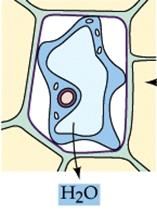 A turgid cell:
A turgid cell:
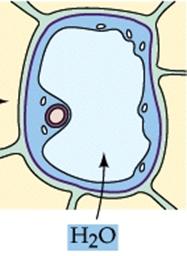
 A turgid cell:
A turgid cell:

Q118. Represent
diagrammatically the pathways of water movement in roots.
Solution
Pathways
of water movement in roots:
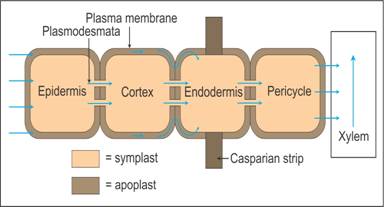

Q119. State the relation between the concentration
of water in a system and its kinetic energy.
Solution
Greater the concentration of water in a
system, higher is its kinetic energy.
Q120. Water potential is expressed in
terms of pressure units, one of which is bar. 1 bar is equal to
Solution
1 bar = 750 mmHg
Q121. Write any one similarity found between enzymes and carrier proteins.
Solution
Like enzymes, carrier proteins carry specific substances across the cell membrane.
Carrier proteins are sensitive to inhibitors.
(Write any one similarity)
Q122. The equation  , where D is diffusion and d is density, is known as
, where D is diffusion and d is density, is known as
Solution
According to Graham’s law, the
rate of diffusion is inversely proportional to the square root of the density
of the diffusing substance.
Q123. Which one of the following will not
directly affect transpiration?
Solution
Chlorophyll content of leaves does not
affect transpiration as it helps the plants during photosynthesis which is
much required for transpiration.
Q124. Represent
the pressure flow hypothesis diagrammatically.
Solution
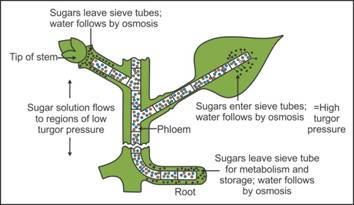
Q125. Munch hypothesis is based on
Solution
Munch hypothesis is
a mass flow or pressure flow hypothesis in which the organic substances move from
the region of high osmotic pressure to the region of low osmotic pressure in
a mass flow due to the development of a gradient of turgor pressure.
Q126. Differentiate
between symport and antiport. Also draw their diagrams.
Solution
Symport
Antiport
In symport, the movement of two molecules occurs
in the same direction.
In antiport, the molecules move in opposite
direction.
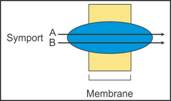
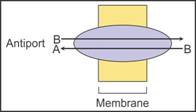


Q127. Distinguish between hypertonic and isotonic
solutions.
Solution
Hypertonic Solution
Isotonic Solution
The
solution does not balance the osmotic pressure of the cell, because its
water potential is lesser than the cytoplasm of the cell.
The
solution balances the osmotic pressure of the cell.
There
is a flow of water outside the cell, and the cell shrinks.
There
is no net flow of water inside or outside, and the cell remains flaccid.
Q128. Give two examples of imbibition.
Solution
Two examples of imbibition are as follows:
Absorption of water by seed
Absorption of water by dry wood
Q129. A raisin was a kept in a bowl containing a
solution for two hours. After two hours, there was increase in the volume and
size of the raisin. Identify the type of solution in which the raisin was
placed.
Solution
Because the raisin swelled up after two
hours, it was kept in a hypotonic solution.
Q130. How much water can a mature plant absorb in a day?
Solution
A mature plant can absorb 3 litres of water in a day.
Q131. Water potential of pure water at
standard temperature is equal to
Solution
Water potential is
the difference in the free energy or chemical potential per unit molal volume
of water in a system and that of pure water at the same temperature and
pressure.
Water potential of
pure water at normal temperature and pressure is zero.
Q132. Define
the following terms about water:
Capillarity
Tensile strength
Solution
Capillarity - It is the ability of water molecules to rise in
thin tubes.
Tensile strength - It is the ability of water molecules to resist
a pulling force.
Q133. Define the
following with respect to plants:
Source
Sink
Solution
Source
- It is a part of the plant which synthesises food.
Sink
- The parts of the plant which require food or store food.
Q134. Name the
two pathways by which water is moved when absorbed by the roots.
Solution
Pathways
by which water is moved when absorbed by the roots are
Apoplast pathway
Symplast pathway
Q135. Name the
process by which unloading of minerals occurs in plant cells.
Solution
The
process by which unloading of minerals occurs by plant cells is through
diffusion.
Q136. Differentiate
between simple diffusion and facilitated diffusion.
Solution
Simple
Diffusion
Facilitated
Diffusion
Carrier
proteins are not involved in the transport of substances.
Carrier
proteins help in the transport of substances across the membranes.
Non-polar
substances are easily transported.
Polar
substances are transported across the membrane.
Q137. Define turgor pressure. How is it useful for
plants?
Solution
Turgor pressure is the pressure exerted by
the protoplast against the rigid cell wall due to the entry of water.
Turgor pressure helps plants in enlargement
and extension growth of cells.
Q138. In which
region of the plant, the apoplast is absent?
Solution
Apoplast
is absent in the casparian strip of the endodermis in the roots.
Q139. Transpiration supplies water for photosynthesis. Justify. Also represent it diagrammatically.
Solution
The concentration of water vapour in the atmosphere is lower than that in the stomata and intercellular spaces.
This results in the loss of water to the surrounding air.
When water evaporates through the stomata, it results in the pulling of water, molecule by molecule, from the xylem into the leaf, thus making water available for plant cells which can be used for photosynthesis.
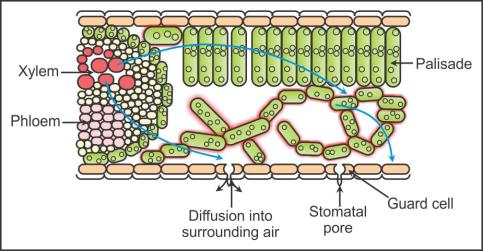

Q140. Name the
plant tissue system responsible for carrying out long-distance transport of
substances in plants.
Solution
The vascular
plant tissue system is responsible for carrying out long-distance transport
of substances in plants.
Q141. How does turgidity
of guard cells help stomata to open or close?
Solution
When the
turgidity inside the guard cells increases, the outer thick walls of the
guard cells bulge out. This creates a force on the inner walls of the guard
cells and they become crescent shape resulting in the opening of stomata.
When the
guard cells lose their turgor due to water loss, the inner walls gain their
original size. The guard cells become flaccid resulting in the closing of the
stomata.
Q142. The total amount of water in the
soil available for the plant is called
Solution
In the soil, the total amount of
water present is called holard, the total amount available to the plant is
called chresard and the water which cannot be absorbed by the plant is called
echard.
Q143. Differentiate
between symplast and apoplast.
Solution
Symplast
Apoplast
Movement occurs through cell walls and
intercellular spaces.
Movement occurs through the cytoplasm and plasmodesmata
by cutting the plasma membrane.
Water movement is faster.
Water movement is slower.
Q144. The
direction of movement of food in the phloem can be bidirectional. Justify.
Solution
Usually, the
source is the part of a plant where food is synthesised and the sink is the
part of the plant where the food is required or stored.
However, it
can be reversed, especially during seasonal changes or according to the
plant’s need.
In the
early spring, sugar stored in the roots is sometimes used and acts as a
source, and the buds of trees which need energy for growth and development of
the photosynthetic apparatus act as a sink.
Hence,
the source-sink relationship is variable in plants, and the direction of
movement of food in the phloem is bidirectional.
Q145. Plasmolysis will occur when the cell is
placed in
Solution
A hypertonic solution
causes exosmosis or withdrawal of water from the cytoplasm. The pressure on
the wall is simultaneously reduced, and the elastic wall contracts causing a
reduction in cell size which is called plasmolysis.
Q146. Define imbibition.
Solution
Imbibition is a type of diffusion where water
is absorbed by solids or colloids and results in an increase in their volume.
Q147. What will happen to the pressure potential of
the cell if it is kept in a hypotonic solution?
Solution
If the cell is kept in a hypotonic solution, then
the pressure potential inside the cell will increase.
Q148. State the
factors which affect the rate of diffusion.
Solution
Factors
affecting the rate of diffusion are as follows:
Concentration gradient
Permeability of the membrane
Temperature
Pressure
Q149. State the names of two components which determine the water potential.
Solution
The components which determine the water potential are as follows:
Solute potential  Pressure potential
Pressure potential 
 Pressure potential
Pressure potential 
Q150. Explain
how molecules are transported through water channels.
Solution
An
extracellular molecule binds to the transport protein.
This
makes the transport protein to rotate and release the molecule inside the
cell.
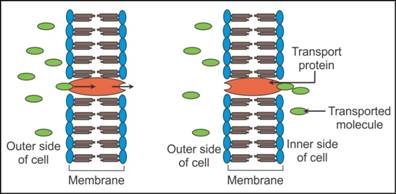

Q151. Why is imbibition said to be a type of
diffusion?
Solution
During imbibition, the movement of water
occurs along the concentration gradient; hence, it is said to be a type of
diffusion.
Q152. Study the given diagram and answer the following questions.
 Draw the same diagram and show the apoplast pathway in the diagram.
Label A, B, C, D and E.
Name the substance present in E.
Draw the same diagram and show the apoplast pathway in the diagram.
Label A, B, C, D and E.
Name the substance present in E.
 Draw the same diagram and show the apoplast pathway in the diagram.
Label A, B, C, D and E.
Name the substance present in E.
Draw the same diagram and show the apoplast pathway in the diagram.
Label A, B, C, D and E.
Name the substance present in E.
Solution
Apoplast pathway:
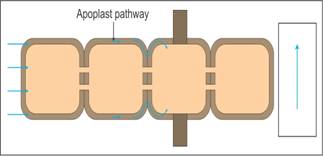 A - Epidermis
B - Cortex
C - Plasmodesmata
D - Xylem
E - Casparian Strips
The substance present in E (Casparian strips) is suberin.
A - Epidermis
B - Cortex
C - Plasmodesmata
D - Xylem
E - Casparian Strips
The substance present in E (Casparian strips) is suberin.
 A - Epidermis
B - Cortex
C - Plasmodesmata
D - Xylem
E - Casparian Strips
The substance present in E (Casparian strips) is suberin.
A - Epidermis
B - Cortex
C - Plasmodesmata
D - Xylem
E - Casparian Strips
The substance present in E (Casparian strips) is suberin.
Q153. Draw a well-labelled
diagram of the stomatal apparatus.
Solution

Q154. In what
way is transpiration significant for plants?
Solution
Significance
of transpiration:
It creates a water column in the xylem
and thus makes the water available for photosynthesis.
It creates the transpiration pull
required for absorption and transportation in plants.
It cools the leaf surfaces by
evaporation of water through stomata.
The shape and structure of plants are maintained
as transpiration keeps the cells turgid.
Transports minerals from the soil to all
parts of the plant.
Q155. Distinguish between osmosis and diffusion.
Solution
Osmosis
Diffusion
It is
the movement of solute molecules across a concentration gradient.
It is the
movement of solvent molecules across the concentration gradient.
It does not require any membrane.
It
occurs through a semipermeable membrane.
Q156. Explain
the three physical properties of water which help in the ascent of sap in
plants.
Solution
Properties
of water which help in the movement of ascent of sap are as follows:
Mutual attraction between water molecules.
This property is called cohesion.
Attraction of water molecules to polar
surfaces such as the surface of tracheary elements. This attraction is
also called adhesion.
Water molecules are attracted to each
other more in the liquid phase than in the gas phase. This property is
called the surface tension of water.
All the
above properties help to form a continuous passage of water molecules in the
xylem which moves upwards due to the transpiration pull.
Q157. Define
root pressure.
Solution
When
different ions are transported actively from the soil to root hair, water
follows a potential gradient, i.e. moves from its higher potential region
(soil) to its lower potential region (root tissues). This increases a
positive pressure inside the roots called root pressure.
Q158. When is a solution called a hypertonic
solution?
Solution
When the external solution is more
concentrated than the content of the cytoplasm, a solution is called a hypertonic
solution.
Q159. Name the
element which cannot be remobilised.
Solution
Calcium
Q160. Explain
the mechanism of the pressure flow hypothesis.
Solution
When
glucose is prepared at the source by photosynthesis, it is converted into
sucrose.
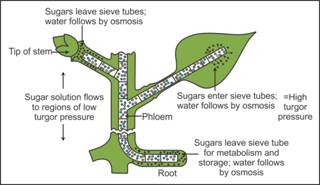 Sucrose
is then transported into the companion cells and then into the phloem sieve
tube cells by active transport. This is called loading of the source.
Loading
creates a hypertonic condition in the phloem due to which water from the adjacent
xylem cells moves into the phloem by osmosis.
As the
osmotic or hydrostatic pressure builds up inside the phloem, the sap moves to
the surrounding areas of the lower osmotic pressure, i.e. the sink.
As the
sucrose moves into the sink, the water potential in the phloem increases
which again moves water into the xylem.
Sucrose
is then transported into the companion cells and then into the phloem sieve
tube cells by active transport. This is called loading of the source.
Loading
creates a hypertonic condition in the phloem due to which water from the adjacent
xylem cells moves into the phloem by osmosis.
As the
osmotic or hydrostatic pressure builds up inside the phloem, the sap moves to
the surrounding areas of the lower osmotic pressure, i.e. the sink.
As the
sucrose moves into the sink, the water potential in the phloem increases
which again moves water into the xylem.
 Sucrose
is then transported into the companion cells and then into the phloem sieve
tube cells by active transport. This is called loading of the source.
Loading
creates a hypertonic condition in the phloem due to which water from the adjacent
xylem cells moves into the phloem by osmosis.
As the
osmotic or hydrostatic pressure builds up inside the phloem, the sap moves to
the surrounding areas of the lower osmotic pressure, i.e. the sink.
As the
sucrose moves into the sink, the water potential in the phloem increases
which again moves water into the xylem.
Sucrose
is then transported into the companion cells and then into the phloem sieve
tube cells by active transport. This is called loading of the source.
Loading
creates a hypertonic condition in the phloem due to which water from the adjacent
xylem cells moves into the phloem by osmosis.
As the
osmotic or hydrostatic pressure builds up inside the phloem, the sap moves to
the surrounding areas of the lower osmotic pressure, i.e. the sink.
As the
sucrose moves into the sink, the water potential in the phloem increases
which again moves water into the xylem.
Q161. Differentiate between hypotonic and
hypertonic solutions.
Solution
Hypotonic Solution
Hypertonic Solution
It has
more water potential than the cytoplasm of the cell.
It has
less water potential than the cytoplasm of the cell.
When
the cell is kept in a hypotonic solution, the cell becomes turgid.
When
the cell is kept in a hypertonic solution, the cell shrinks.
Q162. Study the figure given below in which one region indicates soil and one region indicates root hair cells separated by a semipermeable membrane.
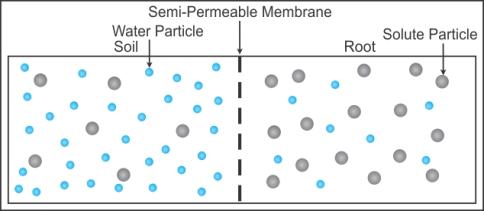 Which region has more water potential? Why?
Will the root cells have more water molecules at equilibrium, yes or no? Justify your answer.
If soil has
Which region has more water potential? Why?
Will the root cells have more water molecules at equilibrium, yes or no? Justify your answer.
If soil has  −1500 kPa and inside the root hair cell
−1500 kPa and inside the root hair cell  is −600 kPa, which region has more
is −600 kPa, which region has more  ?
?
 Which region has more water potential? Why?
Will the root cells have more water molecules at equilibrium, yes or no? Justify your answer.
If soil has
Which region has more water potential? Why?
Will the root cells have more water molecules at equilibrium, yes or no? Justify your answer.
If soil has  −1500 kPa and inside the root hair cell
−1500 kPa and inside the root hair cell  is −600 kPa, which region has more
is −600 kPa, which region has more  ?
?
Solution
The region of soil has more water potential. Since as per the figure, there is more number of water molecules in soil as compared to the root hair cell.
At equilibrium, the root cells will have same number of water molecules as the soil because at equilibrium, there is no net flow of water inside or outside the cell and it is achieved, when the osmotic pressure inside and outside the cell is balanced.
Soil has more  (water potential).
(water potential).
 (water potential).
(water potential).
Q163. What will happen to the solute potential
inside the cell if the cell is kept in a hypertonic solution?
Solution
If the cell is kept in a hypertonic solution,
then the solute potential inside the cell will increase.
Q164. Identify
the process given in the following diagram:


Solution
The symport
process
Q165. In plants, there is a complex traffic of compounds. Justify.
Solution
In plants, water and minerals are transported in one direction from the roots to the stems or the growing regions in the upward direction through the xylem.
Organic compounds formed during photosynthesis are exported from leaves to other parts of the plants including storage organs.
From the storage organs, the organic compounds are later re-exported. This means the organic compounds are transported in different directions.
When a plant undergoes senescence, nutrients are withdrawn from the part of the plant undergoing senescence and are moved to growing parts.
Growth regulators are also transported sometimes either in one direction, i.e. from the region where they are synthesised to the parts of plants where they are required.
There are many substances which are constantly transported in different directions at a time in plants. Hence, it can be said that in plants, there is a complex traffic of compounds.




Comments
Post a Comment